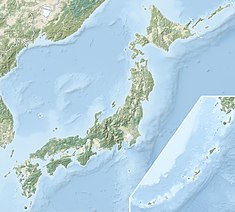Kōzato temple ruins
| Kōzato temple ruins | |
|---|---|
| Native name Error {{native name list}}: an IETF language tag in |tag1= is required (help) | |
 site of the Pagoda at the Kōzato temple ruins | |
| Type | Buddhist temple ruins |
| Location | Mima, Tokushima, Japan |
| Coordinates | 34°3′14.70″N 134°3′34.35″E / 34.0540833°N 134.0595417°E |
| Built | Hakuhō period |
} | |
The Kōzato temple ruins (郡里廃寺跡) is an archaeological site with the ruins of a Hakuhō period Buddhist temple in the Ganshoji, Ichogi neighborhood of the town of Mima, Tokushima Prefecture Japan. Its ruins were designated as a National Historic Site in 1976, with the area under protection extended in 1997. It is the oldest known Buddhist temple ruin in Tokushima Prefecture.[1]
History
The Kōzato temple ruins are located is located on the alluvial plain of the north bank of the middle reaches of the Yoshino River. The local place name of Rikko-ji (立光寺) is recorded from Edo Period records, and roof tiles which have subsequently been dated to the Nara period have been found in this area, indicating that a temple once existed. A large-scale archaeological excavation in 1967 found the foundation stones for the Kondō and Pagoda. From traces of a surrounding earthen palisade and moat, the temple compound was found to occupy an area 94 meters east-to-west by 120 meters north-to-south. The layout of the temple appears to be patterned after Hokki-ji in Ikaruga, Nara, with the Kondō on the right and the Pagoda on the left. The Pagoda foundations included an irregular octagonal stone with a diameter of over a meter, with a 13-centimeter center hole for the pagoda's main spar.
In addition to roof tiles, small pieces of bronze, Haji pottery, Sue pottery, and wooden tally boards have also been excavated from the temple area. There are plans to preserve the ruins as an archaeological park. The excavated roof tiles and other artifacts are stored and exhibited at the Mima Folk Museum and Tokushima Prefectural Museum, located on the precincts of Gansho-ji temple, about 300 meters from the site. [2]
The site is a five-minute walk from the "Teramachi" bus stop on the municipal bus Sadamitsu Station on the JR Tokushima Line.[2]
See also
References
- ^ "郡里廃寺跡" (in Japanese). Agency for Cultural Affairs. Retrieved August 20, 2020.
- ^ a b Isomura, Yukio; Sakai, Hideya (2012). (国指定史跡事典) National Historic Site Encyclopedia. 学生社. ISBN 4311750404.(in Japanese)
External links
- Mima Town home page(in Japanese)
- Tokushima Prefecture home page(in Japanese)


